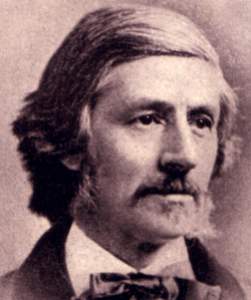Franklin Benjamin Sanborn (American National Biography)
Scholarship
Sanborn was interested in abolitionist politics from an early age, and once settled in Concord he became actively involved in the organized abolitionist movement, developing acquaintances with leaders such as William Lloyd Garrison, Samuel Gridley Howe, Parker, and Wendell Phillips and serving on committees for the colonization and defense of Kansas. These associations led to Sanborn’s meeting John Brown (1800-1859) in late 1856 and to his involvement in Brown’s plot to capture the federal arsenal at Harpers Ferry, Virginia. Sanborn became a member of Brown’s “secret six,” members of the Massachusetts Kansas Committee engaged in raising financing for Brown’s abolitionist activities. When Brown’s attempt to capture the Harpers Ferry arsenal failed on 18 October 1859, Sanborn’s role came under the scrutiny of southern senators investigating Brown’s raid, which led to an attempt by federal marshals to capture Sanborn in Concord on 3 April 1860 and return him to Washington, D.C., to testify about his part in the affair. Sanborn was rescued by the townspeople of Concord, and the U.S. Senate warrant for his arrest was eventually declared illegal by the Massachusetts Supreme Court. Sanborn remained devoted to Brown’s memory for the rest of his life, and he published a biography of him, Life and Letters of John Brown, Liberator of Kansas, and Martyr of Virginia, in 1885. In 1862 Sanborn married Louisa Augusta Leavitt, his cousin; they had three children.
Robert E. Burkholder, "Sanborn, Franklin Benjamin," American National Biography Online, February 2000, http://www.anb.org/articles/15/15-00594.html.



